Thinking about planting a new area or redoing a part of your garden that has gotten out of control? If many of your old favorites just get too big, insects and diseases plague them or they take too much time to prune you need some new favorites. What’s a gardener to do these days when we want our yards to be sustainable? Here are some substitutions for good plants gone wrong. This time it’s gonna be the right plant in the right spot.
Phormiums have been popular for many years now. This plant from New Zealand looks great in low water landscapes providing architectural interest but usually grows much wider and taller than anticipated and next thing you know it’s taken over. One of the cultivars that behaves itself is called Jester. This phormium has beautiful 2-3 ft long pinkish leaves that have an orange midrib and lime green bands near the leaf margins. Combine it with teucrium chamaedrys germander for an awesome combination.
If you want a similar fountain-like plant in your landscape that never reverts to plain green, try a cordyline Festival Grass. Vivid burgundy red leaves to 2-3 ft tall arching over so the tips reach the ground. Tiny pale lilac flowers appear in the summer, with a jasmine-like fragrance. Plant in full sun to part shade and water regularly. Plants in shade have a darker more purple color while sun grown plants have more red.
What’s deer resistant with fragrant, gold foliage, uses little water once established and stays compact? Danny’s Sport Breath of Heaven is a bushy, finely textured shrub of the citrus family. They have slender stems and tiny narrow leaves which give off a spicy, sweet scent when crushed. Bright yellow new growth is upright, growing to 3- 5 ft tall. They thrive in sun or light shade and are hardy to around 18 degrees or less. Use it as a foundation plant, informal hedge or specimen plant. They are very showy in the landscape.
Ornamental oregano is a great perennial to use in a border or to tuck between other plants. Most oregano varieties are wonderful while in bloom but offer little interest after the main show is over. Oregano Santa Cruz is a better choice. Antique-toned, dusty rose-colored hop-like flowers, are offset by bright green calyxes and remain all summer on branched red stems. This plants grows 18" – 24" high and 3 ft wide. For a pleasing fusion of color, combine it with penstemon Blackbird or another rich burgundy penstemon. Add a grass such as muhlenbergia capillaris to complete the vignette.
Everybody loves clematis. They come in so many styles but how do you prune them for best flower production? Plant a 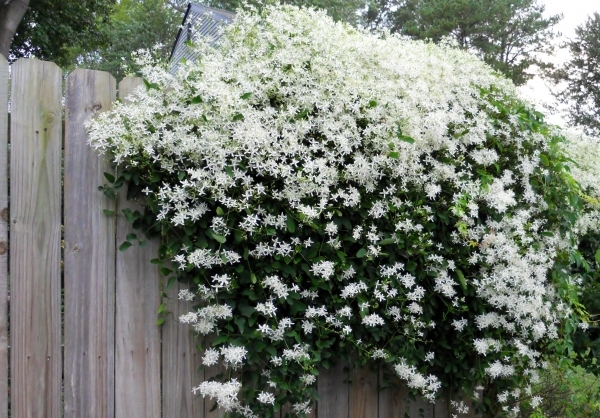 Sweet Autumn Clematis ( clematis terniflora ) and your worries are over. They are a gorgeous sight now covered in pure white, lightly fragrant flowers. Later in the fall the vine will become a silvery mass of fluffy seed heads. This small-flowered species looks impressive covering an upscale arbor or even embellishing a plain fence of garden shed. It blooms on new growth so you can easily keep it in check by cutting stems back to 12" in the spring. It will bloom well in partial shade, too.
Sweet Autumn Clematis ( clematis terniflora ) and your worries are over. They are a gorgeous sight now covered in pure white, lightly fragrant flowers. Later in the fall the vine will become a silvery mass of fluffy seed heads. This small-flowered species looks impressive covering an upscale arbor or even embellishing a plain fence of garden shed. It blooms on new growth so you can easily keep it in check by cutting stems back to 12" in the spring. It will bloom well in partial shade, too.
A smaller cultivar of the old favorite oak-leaf hydrangea is Sikes Dwarf. This lovely plant provides year-round seasonal interest. At this time of year th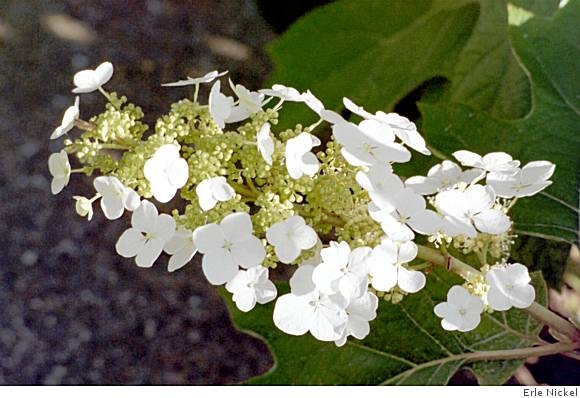 eir huge, whitish-pink conical flowers turn a papery soft tan color. In later autumn, the leaves will take on striking shades of crimson and bronze-purple, and through winter the dry flowers persist above the branches lined with exfoliating copper-brown, cinnamon and tan bark. Oakleaf hydrangeas are fast growing and accept full sun or partial shade in rich evenly moist soil. They’re real lookers in the garden.
eir huge, whitish-pink conical flowers turn a papery soft tan color. In later autumn, the leaves will take on striking shades of crimson and bronze-purple, and through winter the dry flowers persist above the branches lined with exfoliating copper-brown, cinnamon and tan bark. Oakleaf hydrangeas are fast growing and accept full sun or partial shade in rich evenly moist soil. They’re real lookers in the garden.

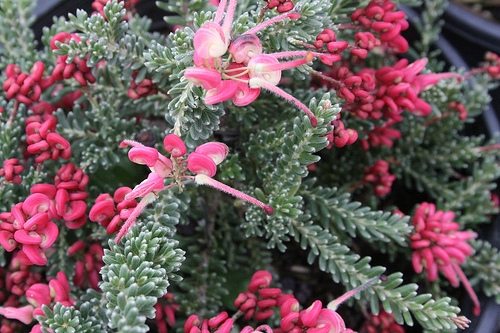
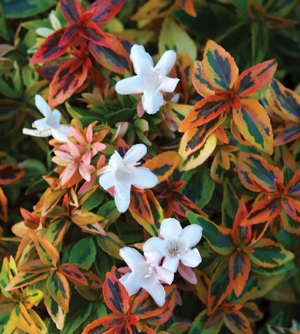 Kaleidescope abelia
Kaleidescope abelia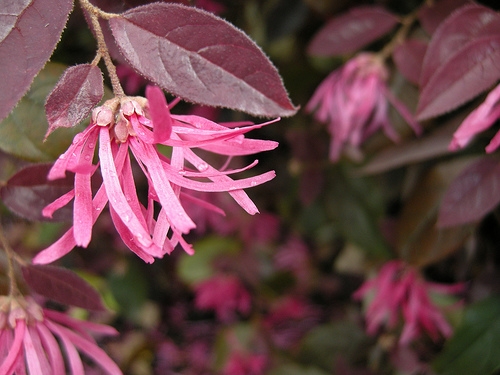 Raspberry flower clusters are heaviest in the spring but some bloom is likely throughout the year. I place this plant in the foreground where you can appreciate it’s graceful shape-looks great as an accent or in a raised bed. The burgundy color can add color to a woodland garden and it even does well in a container on the patio. You can prune it to any size but please don’t turn it into a tight ball and ruin it’s shape. Another plus is that it is not attractive to deer.
Raspberry flower clusters are heaviest in the spring but some bloom is likely throughout the year. I place this plant in the foreground where you can appreciate it’s graceful shape-looks great as an accent or in a raised bed. The burgundy color can add color to a woodland garden and it even does well in a container on the patio. You can prune it to any size but please don’t turn it into a tight ball and ruin it’s shape. Another plus is that it is not attractive to deer. 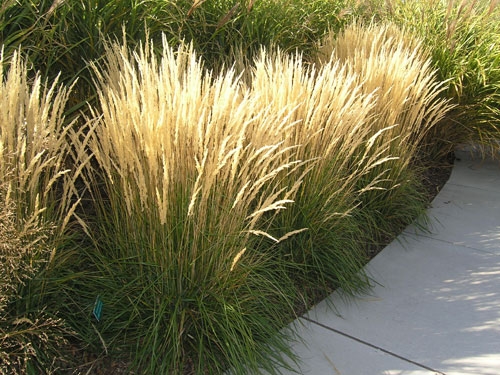 Karl Foerster feather reed grass adds a vertical element to your summer and fall garden. It provides wonderful contrast among low shrubs and perennials. Named after the famous landscape architect and photographer with a love for all aspects of perennial plants, Karl Foerster lived in Germany from 1874 to 1970. This grass won the 2001 Perennial Plant of the Year and although it’s not new on the market it’s an easy to grow ornamental grass that won’t overpower your space.
Karl Foerster feather reed grass adds a vertical element to your summer and fall garden. It provides wonderful contrast among low shrubs and perennials. Named after the famous landscape architect and photographer with a love for all aspects of perennial plants, Karl Foerster lived in Germany from 1874 to 1970. This grass won the 2001 Perennial Plant of the Year and although it’s not new on the market it’s an easy to grow ornamental grass that won’t overpower your space. 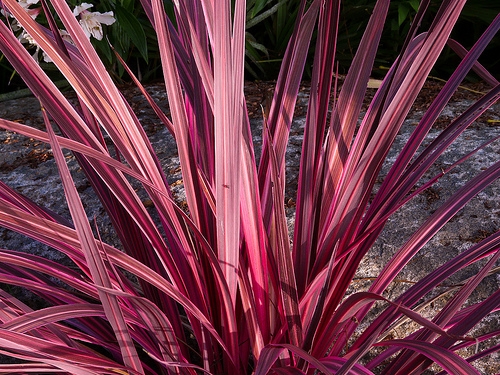
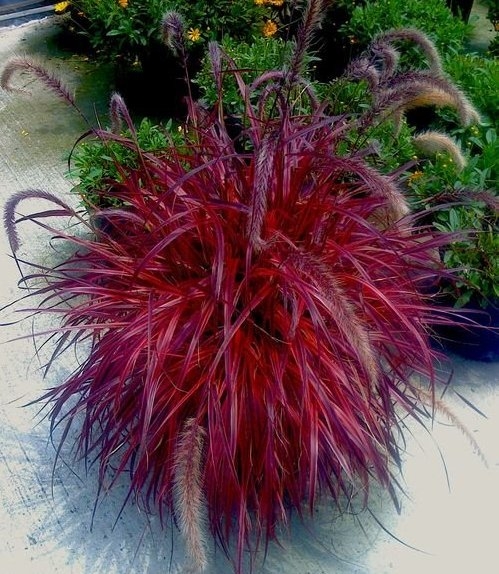 Pennisetum Fireworks
Pennisetum Fireworks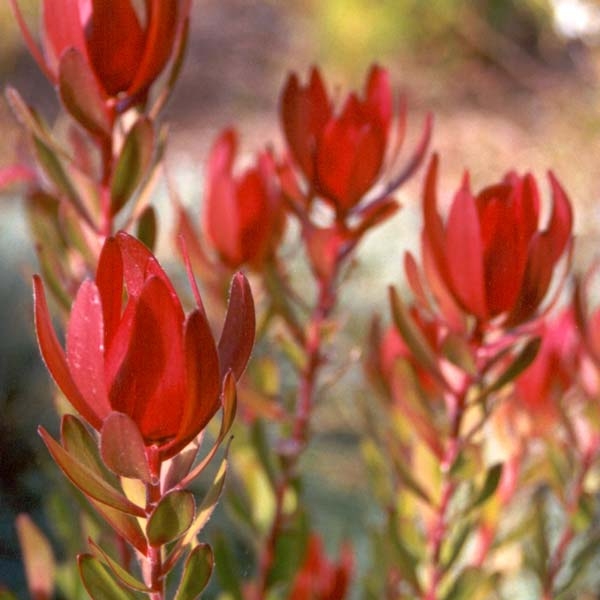 pular Leaucadendron available. It’s a vigorous, erect grower to over 8 feet tall and tough enough to handle frost and clay soils. The flower is actually an insignificant cone surrounded by large colorful bracts which are excellent for cut foliage harvesting.
pular Leaucadendron available. It’s a vigorous, erect grower to over 8 feet tall and tough enough to handle frost and clay soils. The flower is actually an insignificant cone surrounded by large colorful bracts which are excellent for cut foliage harvesting. 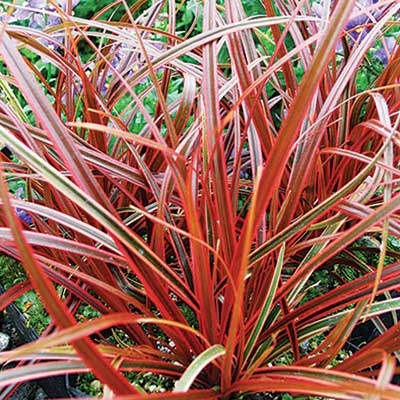
 Euphorbia Diamond Frost blooms continuously with clouds of white flowers that float above finely textured apple-green foliage. This delicate looking perennial may be small in stature, reaching 12-18 " tall and wide, but is easy to grow and surprisingly tolerant of drought and heat. Combine this airy plant with bright colors for a dazzling border.
Euphorbia Diamond Frost blooms continuously with clouds of white flowers that float above finely textured apple-green foliage. This delicate looking perennial may be small in stature, reaching 12-18 " tall and wide, but is easy to grow and surprisingly tolerant of drought and heat. Combine this airy plant with bright colors for a dazzling border.  occasional to regular irrigation. This strong color combination of green and pink doesn’t revert to the parent plants coloring. It’s hardy to 15-20 degrees. You might find this plant also listed as Jubilee.
occasional to regular irrigation. This strong color combination of green and pink doesn’t revert to the parent plants coloring. It’s hardy to 15-20 degrees. You might find this plant also listed as Jubilee. 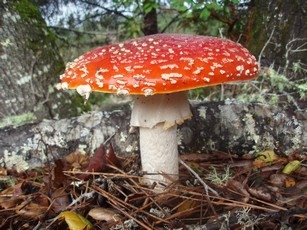
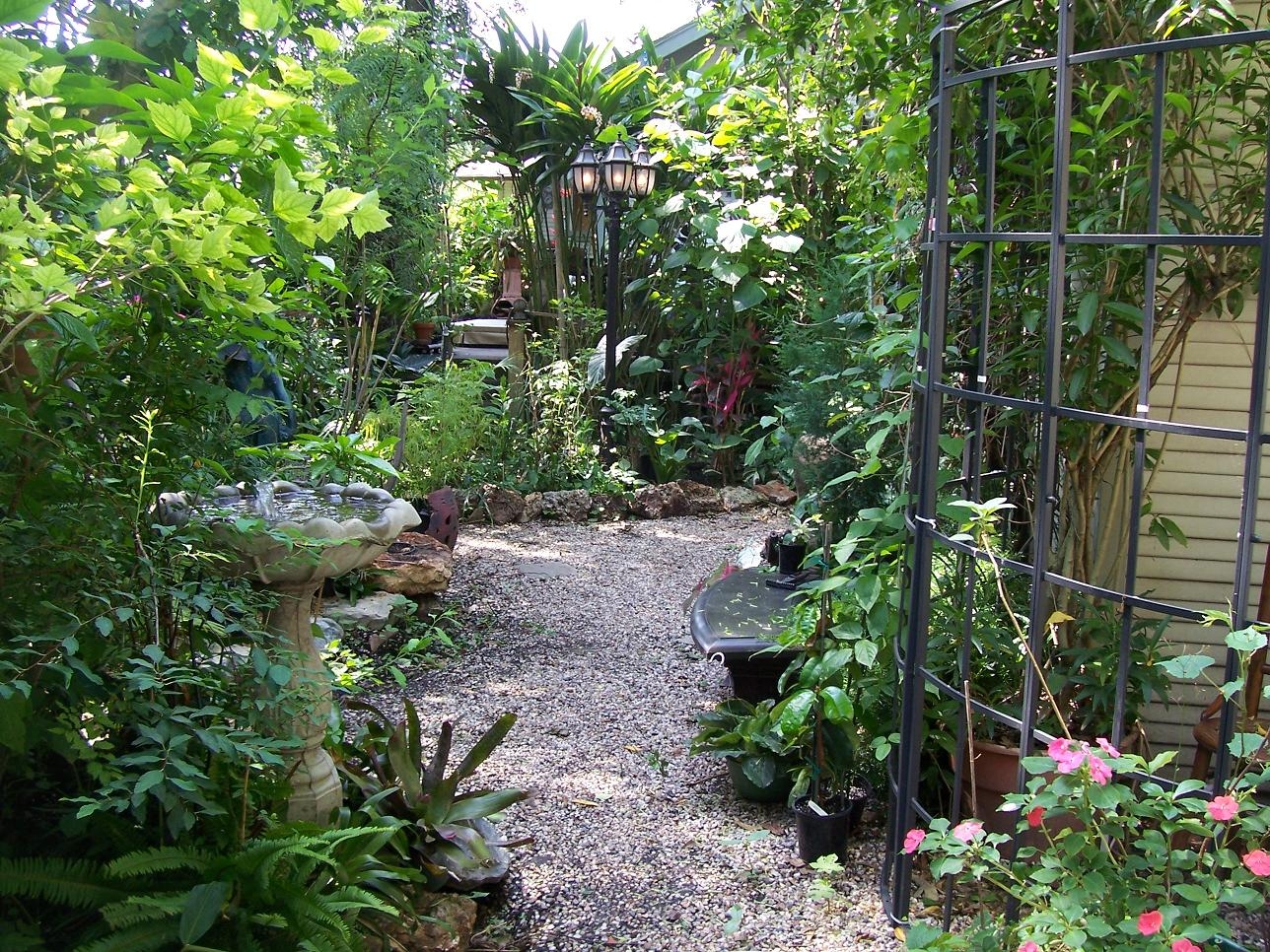
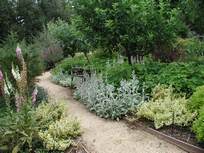 andscapes that provide four seasons of interest. Here are some tips I pass along.
andscapes that provide four seasons of interest. Here are some tips I pass along. 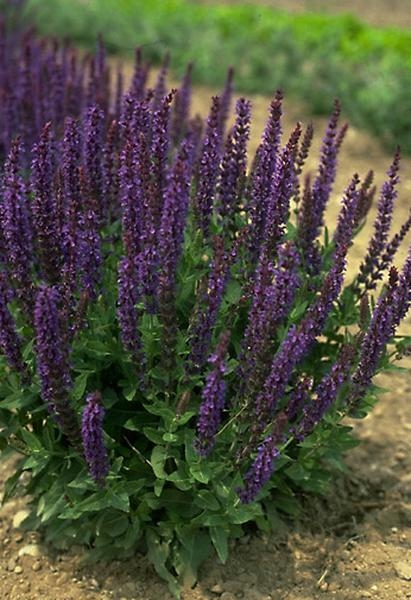 is one such plant and blooms summer through fall if spent stems are removed. Their intense violet-blue flower spikes cover plants 18" tall s
is one such plant and blooms summer through fall if spent stems are removed. Their intense violet-blue flower spikes cover plants 18" tall s.jpg) preading 2-3 ft wide. They look great in wide swaths across the garden or along the border of a path and attract hummingbirds, butterflies, and bees. Walkers Low catmint is another perennial that keeps going and growing. This vigorous spreading member of the mint family blooms profusely with little spikes of 1/2" periwinkle blue flowers from late spring through fall. Catmints are easy to care for. Shear plants back by half at the beginning of the season and after flowers fade. They are drought tolerant, too.
preading 2-3 ft wide. They look great in wide swaths across the garden or along the border of a path and attract hummingbirds, butterflies, and bees. Walkers Low catmint is another perennial that keeps going and growing. This vigorous spreading member of the mint family blooms profusely with little spikes of 1/2" periwinkle blue flowers from late spring through fall. Catmints are easy to care for. Shear plants back by half at the beginning of the season and after flowers fade. They are drought tolerant, too.